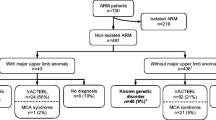Abstract
Objective : To find the prevalence of associated anomalies in children with anorectal malformation (ARM).Methods: One hundred and forty patients (80 males and 60 females) with expand were studied to detect associated anomalies and to find their prevalence. High and low type of ARM was seen in 52.14% and 47.86% of patients respectively. Associated anomalies were more common with high type of ARM (78.08%) than in patients with low type of ARM (37.31%). 58.57% patients had associated anomalies which included those of urinary system (37.14%), vertebral system (34.28%), skeletal system other than vertebral (15.17%), genital system (14.29%), cardiovascular system (12.14%), gastrointestinal tract (10.7%) and spinal cord (10%).Results : 37.43% patients had 3 or more than 3 components of VACTERL association. Two patients had all six components of VACTERL. Most common association was vertebral, anal and renal anomalies seen in 16 patients.Conclusion : Patients with ARM should undergo a detailed general physical, systemic and radiological examination (infantogram, echocardiography, US of urogenital system) in neonatal period to detect associated anomalies in early period
Similar content being viewed by others
References
Alford BA, Mcllhenney J. The newborn and young infant. In Grainger RG, Allison D, eds.Grainger and Allison’s Diagnostic Radiology: A Textbook of Medical Imaging. 3rd edn. New York; Churchill Livingstone, 1997; 1114–1188.
Stringer D. pediatric large bowel. In Freeney PC, Stevenson GW, eds.Margullis and Burhenne’s Alimentary Tract Radiology. 5th end. Philadelphia: Mosby Year Book Inc.; 1994; 1909–1912.
Starer F, Mireaux CD. The pediatric abdomen. In Sutton D, Whitehouse RW, Jenkins JPR, Davies ER, Murget J, Lees WR, eds.Textbook of Radiology and Imaging. 6th end. New York; Churchill Livingstone, 1998; 1094–1096.
Khoury MJ, Cortero JF, Greenberg F, James LM, Erickson JO. A population study of the VACTERL association. Evidence for its etiologic heterogeneity.Pediatrics 1983; 71: 815–820.
Nievelstein RAJ, Vas A, Valk J. MR imaging of anorectal malformation and associated anomalies.Eur Radiol 1998; 8: 573–581.
Boocock GR, Donnai D. Anorectal malformation: familial aspects and associated anomalies.Arch Dis Child 1987; 62:576–579.
Pathak IC, Saifullah S. Congenital anorectal malformations: An experience based on 50 cases.Ind J Pediatr 1969; 36: 370–379.
Metts JC, Kotkin C, Kasper S, Shyr Y, Adams MC, Broek JW. Genital malformations and coexistent urinary tract or spinal anomalies in patients with imperforate anus.J Urol 1997; 158: 1298–1300.
Duhamel B. From the mermaid to anal imperforation: The syndrome of caudal regression.Arch Dis Child 1961; 36: 152–155.
Taneja OP, Sharma MM, Mukerji AC, Taneja S. Management of congenital anorectal malformation in India.Arch Surg 1970; 100:47–57.
Hassink EAM, Rieu PNMA, Hamel BCJ, Severijnen RSVM, Staak FHJV, Festen C. Additional congenital defects in anorectal malformations.Eur J Pediatr 1996; 155:477–482.
Kiesewetter WB, Turner CR, Siebes WK. Imperforate Anus: review of sixteen year experience with 146 patients.Am J Surg 1964; 107:412–421.
Massao E, Hayashi A, Oschihara M, Maie M, Nagasati A, Nishi Tet al. Analysis of 1992 patients with anorectal malformation over the past two decades in Japan.J Pediatr Surg 1999; 34(3): 435–444.
Gough MH. Congenital abnormalities of the anus and rectum.Arch Dis Child 1961; 36:146–151.
Mayo CW, Rice RG, Minn R. Anorectal Anomalies.Surgery 1950; 4:485–494.
Hoekstra WJ, Scholtmeijer RJ, Molenaar JC, Schreeve RH, Schroeder FH. Urogenital tract abnormalities associated with congenital anorectal anomalies.J Urol 1983; 130:962–963.
Denton RJ. The association of congenital spinal anomalies with imperforate anus.Clin Orthop 1982; 162:91–98.
Carson JA, Barner PD, Tunell WP, Smik EI, Jolley SG. Imperforate anus: The neurological implication of sacral abnormalities.J Pediatr Surg 1984; 19(6): 838–841.
Berdon WE, Hochberg B, Baker DH, Grossman H, Santulli TV. The association of lumbosacral spine and geritourinary anomalies with imperforate anus.Am J Roentgen 1966; 98:181–191.
Weiner ES, Kiesewetter WB. Urologic abnormalities associated with imperforate anus.J Pediatr Surg 1973; 8:151–157.
Townes PL, Broeks ER. Hereditary syndrome of imperforate anus with hand, foot and ear anomalies?J Pediatr 1972; 81(2): 321–326.
Churchill BM, Hardy BE, Stephens CA. Urologic aspects of malformations and common abnormalities of the anus and rectum.Urol Clin N Am 1978; 5(1): 141–154.
Belman AB, Kiy LR. Urinary tract abnormalities associated with imperforate anus.J Urol 1972; 108: 823–824.
Fleming SE, Hall R, Gysler M, Mclorie GA. Imperforate anus in females: frequency of genital tract involvement, incidence of associated anomalies, and functional outcome.J Pediatr Surg 1986; 21(2): 146–150.
Mclorie GA, Shelton CA, Fleischer M, Churchill BM. The genitourinary system in patients with imperforate anus.J Pediatr Surg 1987; 22(12): 1100–1104.
Narasimharao KL, Prasad GR, Mukhopadhyay B, Katariya S Mika SK, Pathak IC. Vesicoureteric reflux in neonates with anorectal anomalies.Br J Urol 1983; 55: 268–270.
Boemers TML, Beek FJA, Gool JDV, Jong PVMD, Bax KMA. Urologie problems in anorectal malformations. Part 2: Functional urologie sequelae.J Pediatr Surg 1996; 31(5): 634–637.
Quan L, Smith DW. The VATER association: vertebral defects, anal atresia, T-E fistula with esophageal atresia, radial and renal dysplasia: a spectrum of associated defects.J Pediatr 1973; 82(1): 104–106.
Karrer FM, Flannery AM, Nelson MD, Melone DG, Raffensperger JG. Anorectal malformation: evaluation of associated spinal dysraphic syndromes.J Pediatr Surg 1988; 23(1): 45–48.
Frias MLM, Frias JL. VACTERL as primary, polytopic developmental field defects.Am J Med Genetics 1999; 83:13–16.
Frias MLM, Frias JL, Opilz JM. Errors of morphogenesis and developmental field theory.Am J Med Genetics 1998; 76:291–6.
Author information
Authors and Affiliations
Corresponding author
Rights and permissions
About this article
Cite this article
Mittal, A., Airon, R.K., Magu, S. et al. Associated anomalies with anorectal malformation (ARM). Indian J Pediatr 71, 509–514 (2004). https://doi.org/10.1007/BF02724292
Issue Date:
DOI: https://doi.org/10.1007/BF02724292




